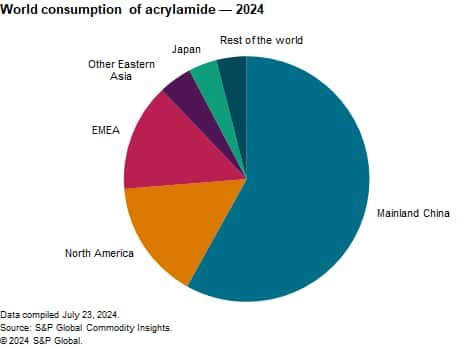Published August 2024
Acrylamide is a water-soluble monomer, industrially produced by the hydration of acrylonitrile. The principal acrylamide derivatives are polyacrylamides (both homopolymers and copolymers) that have varying water solubility characteristics. These polymers are used widely in water treatment, petroleum production, pulp and paper production, mineral processing, and numerous small-volume applications. The bulk of the production and consumption of acrylamide is concentrated in mainland China, the United States and Western Europe, with mainland China accounting for nearly two-thirds of the global production capacity. The merchant market of acrylamide is believed to be rather small, as most producers consume the monomer directly at the site for polyacrylamide manufacture.
The following pie chart shows world consumption of acrylamide:

The acrylamide business is global, as manufacturers locate world-scale production facilities closer to the consumption locations and exploit lower-cost production locations and process efficiencies through new technology and downstream integration. The top-five acrylamide producers account for around 60%of global capacity. International producers such as SNF and Solenis/BASF operate facilities in multiple regions of the world, including North America, Europe and Asia. However, the number of large mainland Chinese producers is increasing.
The water management, oil and gas, and pulp and paper industries are the major consumers of acrylamide/PAM, accounting for more than 85% of total consumption. Water management is the leading segment in the United States and Western Europe, while paper uses dominate the Asian market. EOR will continue to be the largest segment in mainland China, followed by water treatment.
Future growth in demand will be driven primarily by the increasing use of polyacrylamide in the water management sector in India and mainland China. Use in paper is expected to have limited growth in developed economies, whereas it should increase at a quicker rate in Asia (excluding Japan). The North American acrylamide market should see some growth in petroleum processes, such as hydraulic fracturing and EOR.
For more detailed information, see the table of contents, shown below.
S&P Global’s Chemical Economics Handbook – Acrylamide is the comprehensive and trusted guide for anyone seeking information on this industry. This latest report details global and regional information, including

Key Benefits
S&P Global’s Chemical Economics Handbook – Acrylamide has been compiled using primary interviews with key suppliers and organizations, and leading representatives from the industry in combination with S&P Global’s unparalleled access to upstream and downstream market intelligence and expert insights into industry dynamics, trade and economics.
This report can help you
- Identify trends and driving forces influencing chemical markets
- Forecast and plan for future demand
- Understand the impact of competing materials
- Identify and evaluate potential customers and competitors
- Evaluate producers
- Track changing prices and trade movements
- Analyze the impact of feedstocks, regulations, and other factors on chemical profitability


















